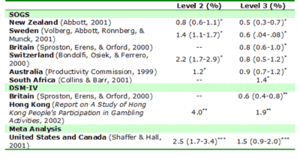The WAGER Vol. 7(51) – Disordered Gambling as an International Phenomenon
The past few years have seen a surge in national gambling prevalence studies. This week’s WAGER takes a trip around the globe to review the epidemiologic evidence on disordered gambling. Table 1 presents estimates of disordered gambling in nine countries from five continents.
Table 1. International Past Year Gambling Prevalence Estimates (95% Confidence Limits)
* Estimate based on the SOGS measure
** Estimate based on DSM-IV diagnostic criteria
*** Estimate based on a meta-analysis
Researchers in different countries have observed similar rates of level 2 (i.e., problem) and level 3 (i.e., pathological) gambling. The central estimates of the prevalence of level 3 gamblers in Table 1 average 1%, ranging from a low of half a percent in New Zealand to a high of 1.9% in Hong Kong. Because measures obtained from samples of the population may vary from the true population prevalence, reported sample statistics are usually accompanied by confidence intervals that define the range of values likely to contain the true population value. The 95% confidence interval (i.e., we would estimate that the probability is 95% that the true population prevalence falls within the confidence interval) was published for survey samples in six of the studies. Figure 1 indicates the similarity of prevalence by noting that all the confidence intervals overlap, and we could not confidently consider the prevalence of Level 3 gamblers to differ across studies. We should note that the largest prevalence estimates, from New Zealand and Hong Kong, did not provide information on the sampling variation. Although gambling participation is thought to reflect geographic differences in cultural attitudes, availability and industry maturity, estimates of disordered gambling appear to be relatively consistent across international borders.
Figure 1. Prevalence and Confidence Limits of Level 3 Gambling
Comments on this article can be addressed to Richard LaBrie and Rachel Kidman.
References
Abbott, M. W. (2001). Problem and non-problem gamblers in New Zealand: A report on phase two of the 1999 National Prevalence Survey (6). Wellington: New Zealand: The Department of Internal Affairs.
Bondolfi, G., Osiek, C., & Ferrero, F. (2000). Prevalence estimates of pathological gambling in Switzerland. Acta Psychiatrica Scandinavica, 101(6), 473-475.
Collins, P., & Barr, G. (2001). Gambling and problem gambling in South Africa: a national study: National Center for the Study of Gambling.
Productivity Commission. (1999). Australia’s Gambling Industries: Final Report (10). Canberra: AusInfo.
Report on A Study of Hong Kong People’s Participation in Gambling Activities. (2002). Centre for Social Policy Studies of The Department of Applied Social Sciences & The General Education Centre of The Hong Kong Polytechnic University.
Shaffer, H. J., & Hall, M. N. (2001). Updating and refining meta-analytic prevalence estimates of disordered gambling behavior in the United States and Canada. Canadian Journal of Public Health, 92(3), 168-172.
Sproston, K., Erens, B., & Orford, J. (2000). Gambling behaviour in Britain: results from the British gambling prevalence survey. London: National Centre for Social Research.
Volberg, R. A., Abbott, M. W., Rönnberg, S., & Munck, I. M. E. (2001). Prevalence and risks of pathological gambling in Sweden. Acta Psychiatrica Scandinavica, 104(4), 250-256.

